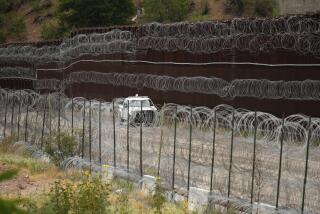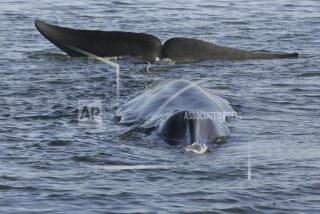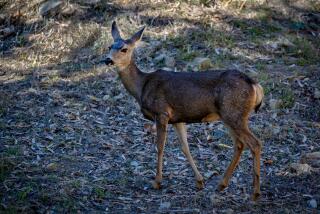Hunters Given Federal OK to Shoot More Birds
WASHINGTON — The government gave hunters new freedom Friday to shoot hundreds of thousands of additional snow geese as they migrate north--an attempt to protect imperiled Canadian tundra from the birds’ voracious appetites.
The Interior Department said it will allow 24 states to ease restrictions on the hunting of snow geese, hoping to double the number killed during their upcoming spring migration.
An estimated 1.2 million birds are expected to be shot, officials of the U.S. Fish and Wildlife Service said. Over the past three decades, the population of snow geese has exploded from 800,000 birds to an estimated 5 million.
Although is it endorsed by many conservation and hunting groups, the plan was immediately denounced by the Humane Society of the United States. It promised a lawsuit, saying the expanded hunt violates laws protecting migratory birds.
The ecosystem problem ought to be resolved in the arctic and “not by the indiscriminate slaughter of birds” as they migrate, said John Grandy, the group’s vice president.
The easing of the rules takes effect Tuesday and begins a campaign to address what has emerged as a major environmental concern: the destruction of thousands of acres of tundra and salt marshes in Canada’s Hudson Bay area.
The area is the summer breeding ground for snow geese, which are white with black wing tips and considerably smaller than better-known Canada geese. During the warm months, the birds grub into the tundra, destroying plant roots and the area’s thin layer of topsoil. That disturbs the feeding grounds for other migratory birds.
“If we do not take action, we risk not only the health of the arctic breeding grounds, but also the future of many of America’s migratory bird populations,” said Fish and Wildlife Director Jamie Rappaport Clark.
The new rules allow states to extend the goose hunting season and let hunters use now-banned electronic goose calls. It also will free hunters to carry more shells in their shotguns, increasing their firepower.
The spring migration of millions of snow geese is just beginning. They have spent the winter in the Gulf Coast and the Southwest. Their northward path takes them up the Mississippi Valley and along flyways that stretch into the upper plains states and the western Great Lakes.
Federal officials say their goal is to cut the number of breeding snow geese by 50%, a task expected to take five to seven years even under the aggressive campaign of expanded hunting and other measures.
The hunting restrictions alone will not reduce the population enough to save the arctic tundra, said Dan Ash, assistant director for refuge and wildlife.
“This is just the beginning to address this ecological crisis,” said Ash. “It’s a first step.”
The agency plans a broader environmental assessment next year to determine what future steps to take to reduce the bird population, including possibly killing young birds in their Canadian breeding grounds.
Conservationists say the problem is really of society’s making. Each winter the geese gorge themselves on the abundant grains and friendly environs of America’s agricultural heartland, growing so hardy they are now able to withstand the harsh arctic climate. The average age of a snow goose is eight years, biologists say.
The result has been “a growing environmental problem” that threatens an array of wildlife, including many waterfowl that share the tundra, from sandpipers to Canada geese.
Actions to reduce the number of snow geese--including less restrictive hunting--have been endorsed by conservation groups such as the Audubon Society and Ducks Unlimited, whose members include many hunters.
“Simply letting nature take its course is no longer valid,” said Frank Gill, senior vice president of the Audubon Society.
The states covered by the new hunting rules are Alabama, Arkansas, Colorado, Illinois, Iowa, Kansas, Louisiana, Minnesota, Mississippi, Missouri, Montana, Nebraska, New Mexico, North Dakota, Oklahoma, South Dakota, Texas, Wyoming, Indiana, Kentucky, Michigan, Ohio, Tennessee and Wisconsin.
More to Read
Sign up for Essential California
The most important California stories and recommendations in your inbox every morning.
You may occasionally receive promotional content from the Los Angeles Times.










